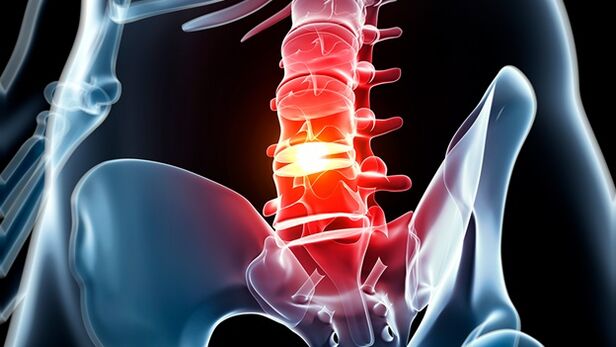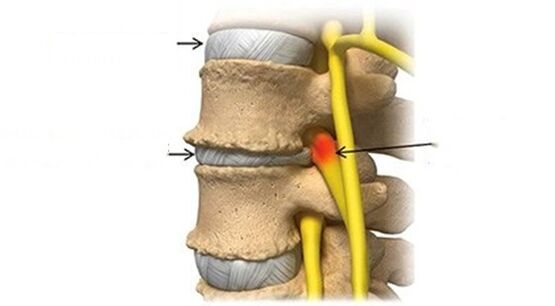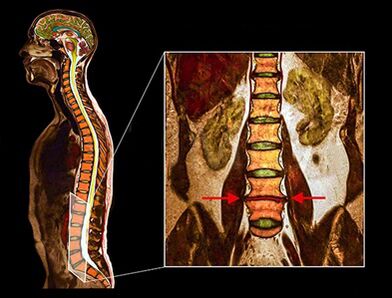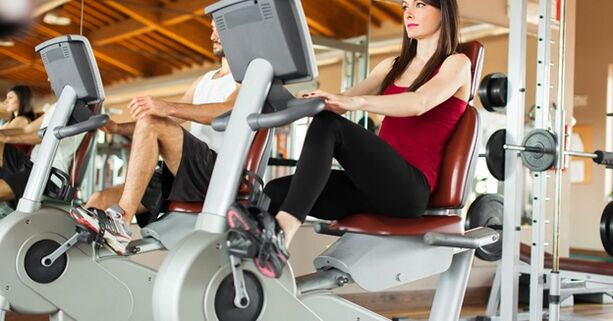Osteochondrosis (degenerative discs of discs) in the lumbar spine or lower spine is due to incorrect changes in the discs, which leads to back pain.
Intervertebral discs are difficult, fibrous structures that act as ligaments between the vertebrae, absorb strokes and ensure the absorption of spinal shock.The discs are elastic, but strong enough to facilitate movements, such as body slope, front, back or sides.
Despite the name, osteochondrosis is not considered a real disease and the symptoms over time, as a rule, does not deteriorate.Disks, as well as all body structures, degradation and disk degeneration develop in all people as part of the involvement process.
A characteristic feature of osteochondrosis is a gradual decrease in symptoms as the spine begins to stabilize.The treatment of lumbar spine osteochondrosis is focused on minimizing pain, stabilizing the spine and improving or maintaining mobility.
Symptoms

Most cases of manifestation of lumbar spine osteochondrosis are to have a mild, persistent back pain, which occasionally intensifies for several days or more.
Symptoms may change, but most features include:
- Moderate, persistent back pain.Pain in the damaged disk is the most common symptom of disk degeneration.The pain can spread to the buttocks, groin and upper thigh.This pain usually feels dumb, and the intensity can vary from light to severe.
- Periodic acute pain episodes.Back pain can intensify for a few days or weeks, and then turn to a more moderate level.Pain spreads appear as degeneration and dip while the spine gradually stabilizes.Pain spread can occur suddenly and manifestations of pain often lead to a decrease in mobility.
- Local pain.The lower part of the back surrounding the degenerate disc may be sensitive to the touch.Local pain is caused by inflammation and muscle tension in the disk area damaged by degeneration.
- Pain in the legs.Neurological symptoms, including numbness, weakness or sharp pain, shots in the buttocks, hips and / or the back of the foot, can be felt if the height of the disk is significantly reduced, and conditions for compression of the nerve root arise.Pain in the legs with osteochondrosis of the lumbar spine usually does not fall under the knee.
- A feeling of sudden weakness or instability can occur with a significant disk weakening and the patient creates that the lower back is not fully performing his functions.
In addition, the pain can intensify or decrease when you perform certain movements or poses, such as:
- In -country pain.Lowering during long periods often causes increased pain in the back and stiffness and decreases after birth or change.
- Strengthening pain with sloping or rotation.Sliding spine and front, back or lateral slope can cause severe pain in the damaged disc.
- Reduction of pain when walking or changing position.When the spine changes the position, the pressure on the disc is reduced or redistributed by the discs in the muscles and joints.Frequent positions, alternating stay and landing, as well as short walks can help reduce stiffness and minimize pain.
Disk degeneration should not cause symptoms of dysfunction / bowel bladder, fever with back pain, unexplained and rapid weight loss or intense abdominal pain.These symptoms indicate more serious conditions and often require operative methods of treatment.
The associated symptoms
With osteochondrosis of the lumbar spine, in addition to back pain, other symptoms associated with disk degeneration may occur.For example:
- Proteins involved inside the disk can cause significant inflammation if they come into contact with the surrounding spinal structures, and this inflammation can lead to spasms of the lower back muscles, as well as radial pain, radiation in the hips and the posterior surface of the lower extremities (also called Ishias).
- The degeneration of the lumbar disc can contribute to the development of lumbar stenosis and / or lumbar osteoarthritis, as well as other conditions at the lower back.
- A degenerate disk can also lead to the appearance of a hernia of the intervertebral lumbar disc.Neurological symptoms with a hernia of a disc can be acute and intense.
- Symptoms caused by degeneration of the disk in the lumbar spine may vary widely depending on how quickly or completely the disk is subjected to degeneration and how it affects the surrounding spinal structures.
- Pain for osteochondrosis is usually caused by deformity of the muscles that support the spine and inflammation around the disk structures.
Causes of lumbar back osteochondrosis
Osteochondrosis occurs due to age coating and disk structure disorders, and the process of degeneration can be accelerated due to damage, general condition, health and lifestyle, and, perhaps, a genetic predisposition to the development of pathological processes in the muscular system.

Osteochondrosis rarely begins with a serious injury, such as a car accident.It is more likely that the onset of degenerative processes is associated with a low -energy disk damage.
The pain of the law associated with lumbar osteochondrosis are usually generated by one or more pathological processes:
- Inflammation, disk proteins are irritated by the surrounding nerves - both small nerves in the disc and potentially large nerves that go to the leg (sciatica).
- The abnormal instability of the micro, when the outer disc rings, called fibrous rings, wear out and cannot effectively absorb the energy vectors in the spine, which leads to motion along the vertebral segment.
- For a long period of time, pain in the osteochondrosis of the lumbar spine eventually decreases, and does not deteriorate.This relief of pain occurs because the disk completely damaged by degeneration no longer has inflammatory protein (which can cause pain) and the sleep disk goes through a stable position, eliminating the pain-causing micro-movements.
Risk factors
Life factors that affect the general state of health can affect intervertebral discs.The risk factors of a degenerative disk disease (osteochondrosis) include:
- Family history of back pain or skeletal and muscle disorders
- Excessive load at the bottom of the back, due to sports game, or the nature of the work
- Long static loads on discs due to prolonged places and / or poor behavior
- Lack of discs support due to weak back muscles
- Thickening
- Smoking or any form of nicotine consumption
Disk degeneration is part of the aging of the body, but not all people develop pain or any particular symptoms.Symptoms tend to occur in case of instability, muscle tension and, perhaps, irritation of the nerve root.
Troubleshooting
- The history of the disease involves a detailed study of symptoms in the patient, their intensity and the relationship of pain to the loads or body position.Information about regular physical activity, sleep habits and past injuries are also needed.
- A physical examination is needed to study the range of movements and the condition of muscle crust.The presence of painful areas in palpation or physical abnormalities is also determined.Moreover, neurological tests are performed to determine a neurological deficit.
- The above diagnostic methods are usually sufficient for the diagnosis of osteochondrosis, but an accurate diagnosis requires the use of visualization methods.
- c T
- Radiograph
- Msct
- burnish
- MRI - this diagnostic method allows you to clarify the degree of degeneration, the presence of fractures, hernias of stenosis discs.Often an MRI study is needed in the preparation of surgical treatment in order to accurately determine the location of the degenerate disk and plan the operation.

Studies have shown that the results of MRI with moderate or important disks degeneration are found when scanning patients, both with severe and minimal pain or lack of pain.In addition, many painful conditions may not appear in an MRI.For this reason, the diagnosis cannot be made exclusively on the basis of visualization results, and verification of the diagnosis is only possible based on the entirety of all methods of clinical and instrumental examination.
Treatment
Initial methods of treating osteochondrosis of the back and pain manifestations usually include the following combinations:
- Excessive They can reduce inflammation, which contributes to discomfort, stiffness and irritation of the nerve roots.
- Recipe.In severe pain, muscle relaxants or narcotics sedatives may be prescribed.These medicines are usually used to treat intense, acute pain, which is expected to last more than a few days or weeks.These medicines can cause addiction and cause serious side effects, so they should be used with caution.
- Heat and ice.The use of heat in the lower back improves blood circulation, which reduces muscle cramps and tension and improves mobility.Ice packages can reduce inflammation and relieve moderate pain.It is useful to use heat before physical exercise to relax muscles and use ice after physical activity in order to minimize inflammation.
- Manual therapy. Whose manipulation is performed by a specialist is a popular method of controlling pain in back pain.Practicing doctors, manual therapists, use their hands to affect different areas of the body in order to reduce tension in muscles and joints.It was found that manipulations are an effective measure for reducing temporary pain, and in some cases it is as effective as medication therapy.
- Massage.Exposure by massage methods can reduce tension and cramps on the lower back muscles, reduce pressure on the spine and relieve pain.Moreover, therapeutic massage can improve blood circulation, ensuring the distribution of nutrients and oxygen to the tense muscles.
- Epidural steroid injections.Introducing steroids into the space around the spine can reduce pain impulses as well as inflammation.Steroid injection can be used in combination with the physical therapy program to relieve pain during physical exercise and rehabilitation.As a rule, epidural steroid injection allows to reduce pain by a period of several weeks in one year.
In many cases, for effective anesthesia, a combination of treatment methods is needed.The process of test and error, as a rule, is needed to choose a treatment that turns out to be the most effective.
Long bed rest is not recommended, and, as a rule, immobilization is possible with severe pain for a short period of time, as lack of physical activity can lead to muscle weakening and normal spine support.
Exercise therapy and activity modification

To maintain the healthy movement of the spine, physical exercise is needed.An effective exercise program for the lumbar spine should include:
- Extension exercises for the lower back muscles, thighs and pelvis, as well as damage muscles.The seal of these muscles increases the pressure on the lumbar spine and contributes to the development of back pain.
- Energy exercises in the lower back and abdominal muscles allow you to maintain good behavior and it is best to maintain spine.The exercise program to strengthen muscles may include an individual exercise therapy program, dynamic stabilization of the lumbar spine, TAI-chi, pilates or others.
- Aerobic exercises with a low level of load, which increase the frequency of heart contractions, improve blood circulation and provide nutrients and oxygen, which is needed to restore body tissue.For example, it can be standing, swimming and water aerobics.
Physical exercise programs are usually adapted to each case, depending on the general state of health, the severity of pain and personal preferences.
Moreover, small adjustments in everyday activity (lifestyle modification) can effectively relieve pain.For example, wearing a corset when lifting weights or avoid turning when lifting weights can prevent increased pain due to excess discs.Using an ergonomic chair and an orthopedic mattress can also improve behavior and reduce the load on the disc.
Surgical treatment
Surgical treatment of lumbar spine osteochondrosis is needed in cases where conservative treatment for 6 months was inefficient.Surgical treatment for osteochondrosis is always selective, which means that the patient himself decides whether or not the surgery should undergo.
It is recommended to consider all factors before deciding on an operation for osteochondrosis, including the duration of the recovery period, treatment of pain during recovery and spinal rehabilitation.
Vertebrates
The standard surgical treatment of lumbar spine osteochondrosis is a joint operation in which two beads are passed together.The purpose of the joints (spondylodesa) is to reduce the pain and eliminate instability in the motor segment of the spine.
All spinal fold operations are as follows:
- Damaged disk is completely removed from the intervertebral space.
- Stabilization is carried out using a bone transplant and / or tools (implants, tiles, rods and / or screws).
- Then vertebrae's vertebrae, forming a solid structure, without movement.Fighting occurs within a few months after the procedure, and not during the operation itself.
After surgery, wearing a corset is described to get analgesics.The exercises are very carefully linked, taking into account the individual characteristics of the patient and the degree of tissue regeneration.Complete healing after union can take up to one year until the beads grow together.
Surgical replacement of an artificial disk
Replacing the disk damaged with an artificial implant has developed in recent years as an alternative to merger.The disk replacement operation consists of complete disk removal damaged by degeneration, restoration of the disk space to natural height and implantation of the artificial disk.
This procedure is designed to maintain movement in the back similar to natural movements, reducing the chance of increasing pressure in the neighboring spinal segments (very common spinal melting complications).
Post -disk replacement surgery usually lasts up to 6 months.






















